L'Oréal Bundle
How Does L'Oréal Dominate the Beauty Industry?
L'Oréal's journey, from a Parisian hair dye innovator to a global beauty powerhouse, is a masterclass in strategic sales and marketing. Its iconic tagline, 'Because You're Worth It,' launched in 1971, remains a powerful statement of empowerment, resonating with consumers worldwide. This article explores the dynamic strategies behind L'Oréal's enduring success and market leadership, analyzing how they've built a global brand.
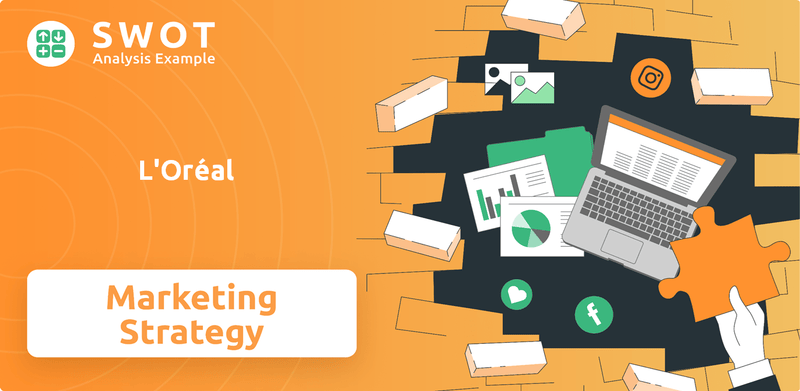
From its humble beginnings, L'Oréal's L'Oréal SWOT Analysis reveals a company that has consistently adapted and innovated. This includes a deep dive into L'Oréal's L'Oréal sales strategy and L'Oréal marketing strategy, examining how they reach their L'Oréal target market. We'll dissect their L'Oréal marketing plan, exploring the L'Oréal brand and diverse L'Oréal products that have cemented its position in the competitive beauty landscape, and its L'Oréal sales and marketing tactics.
How Does L'Oréal Reach Its Customers?
The sales strategy of L'Oréal hinges on a multifaceted approach, utilizing a diverse range of sales channels to ensure wide market coverage. This strategy includes both online and offline avenues, allowing the company to reach a broad spectrum of consumers. The extensive distribution network is designed to cater to various customer segments, from those seeking value to those desiring luxury products.
L'Oréal's distribution network encompasses mass-market retailers, department stores, pharmacies, perfumeries, hair salons, branded stores, travel retail, and e-commerce platforms. This comprehensive approach is crucial for the company's ability to meet the diverse needs and preferences of its global consumer base. The company's ability to adapt and evolve its sales channels is a key factor in its continued success.
The evolution of L'Oréal's sales channels has seen a significant shift towards digital adoption and omnichannel integration. This strategic move is reflected in the company's e-commerce performance and its focus on providing exceptional experiences through both beauty advisors and online services. The company's 'Beauty Stimulus' Plan further emphasizes the extension of innovations into new markets and product launches through various channels.
L'Oréal's e-commerce sales reached €12.3 billion in 2024, representing 28.2% of consolidated sales. This shows a 7.8% growth, highlighting the company's strong emphasis on digital channels. This includes its own brand websites and collaborations with e-commerce pure players, showcasing a robust Revenue Streams & Business Model of L'Oréal.
L'Oréal Luxe prioritizes an omnichannel strategy to provide exceptional products and experiences. This approach combines beauty advisors with online services to enhance customer engagement and satisfaction. The goal is to create a seamless shopping experience across all channels.
Key partnerships and exclusive distribution deals play a crucial role in L'Oréal's growth and market share. The company strategically acquires brands and takes minority stakes in others, such as the acquisition of the Miu Miu license and Korean brand Dr. G, and minority stakes in Galderma and Amouage in 2024. These acquisitions and partnerships boost its portfolio.
Dermatological beauty was L'Oréal's major growth segment in 2024, growing 9.8% like-for-like. This highlights the company's focus on expanding into specialized segments. This expansion strategy is a key component of the L'Oréal marketing plan.
L'Oréal's sales strategy involves a blend of online and offline channels to reach its target market. This includes mass-market retailers, department stores, and e-commerce platforms. The company's approach is designed to maximize sales performance analysis and adapt to consumer behavior.
- Mass-Market Retailers: Products are widely available, ensuring broad consumer reach.
- E-commerce Platforms: Own brand websites and collaborations drive digital sales.
- Department Stores: Offer premium products and enhanced customer service.
- Pharmacies and Perfumeries: Focus on specialized product offerings.
L'Oréal SWOT Analysis
- Complete SWOT Breakdown
- Fully Customizable
- Editable in Excel & Word
- Professional Formatting
- Investor-Ready Format
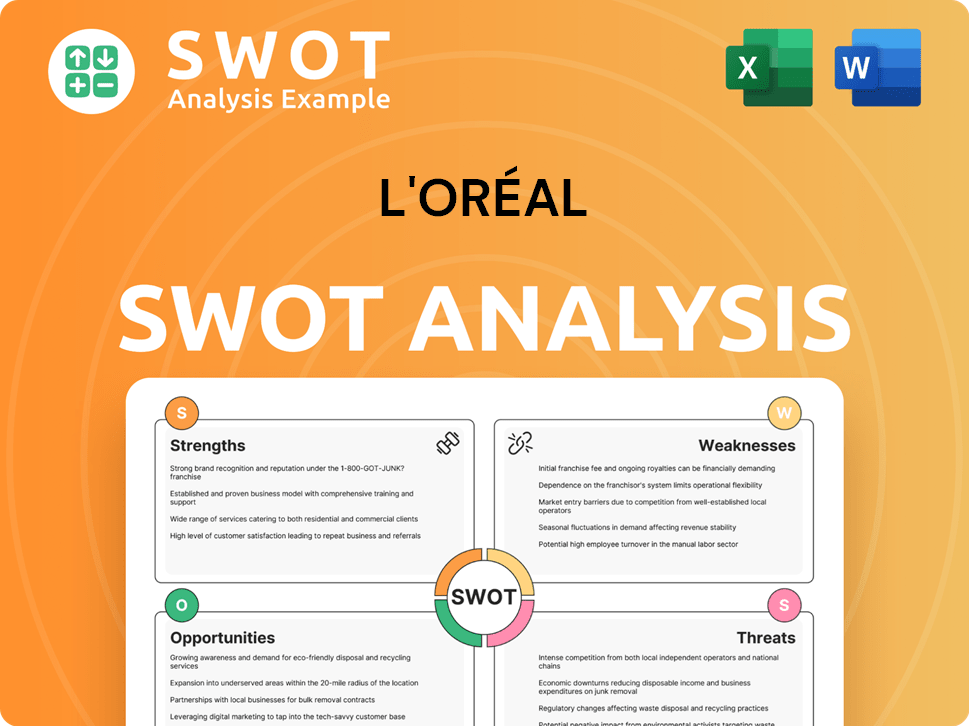
What Marketing Tactics Does L'Oréal Use?
The marketing tactics employed by L'Oréal are multifaceted, blending digital innovation with traditional methods to boost brand awareness, generate leads, and drive sales. The company's approach to its L'Oréal marketing strategy is highly data-driven, focusing on customer segmentation and personalization to enhance the consumer experience.
L'Oréal's strategy emphasizes digital marketing, with a significant portion of its budget allocated to social platforms. This digital focus is supported by advanced technologies like generative AI, which accelerates content creation and localization. Simultaneously, the company continues to utilize traditional media channels, ensuring a comprehensive approach to reach its target market.
The company is integrating AI into its global marketing strategy, viewing it as a tool for transformation. This includes collaborations to develop AI models for product innovation and sustainability. Furthermore, L'Oréal uses AI tools to automate paid media, improving efficiency and campaign effectiveness.
In 2023 and continuing into 2024, over 60% of L'Oréal's digital media budget was dedicated to social platforms. This reflects a strong emphasis on digital channels for reaching consumers.
L'Oréal's CREAITECH lab utilizes generative AI to create localized visuals and campaign assets. This innovation reduces campaign turnaround times from weeks to hours, enabling scalable localized messaging.
Announced in January 2025, L'Oréal is collaborating with IBM to develop a custom generative AI formulation foundation model. This model will enhance product innovation and support sustainability goals by analyzing ingredient data and reducing waste.
The L'Oréal Paris Beauty Genius, an AI-powered virtual beauty assistant, provides personalized product curation, diagnostic services, and virtual try-on experiences. This service aims to offer one-to-one, personalized guidance at scale.
The AI tool Tidal, used to automate paid media, showed a 22% increase in media efficiency and a 14% improvement in campaign effectiveness during a 2023 Nordic rollout.
L'Oréal aims for 'ultra-personalisation' through beauty tech, supported by a team of 4,000 scientists, 6,300 digital talents, and 3,200 tech and data experts. This focus highlights the importance of personalized customer experiences.
L'Oréal's L'Oréal sales strategy and marketing plan include a blend of digital and traditional tactics to reach its diverse L'Oréal target market. The company leverages various strategies to maintain its position in the competitive beauty industry.
- Digital Marketing: Utilizes social media campaigns, content marketing, and paid advertising across platforms like TikTok and Instagram.
- AI Integration: Employs AI for content creation, product innovation, and automating paid media to improve efficiency.
- Personalization: Focuses on 'ultra-personalisation' through beauty tech, offering personalized product recommendations and virtual try-on experiences.
- Traditional Media: Continues to use TV, radio, and print media to complement its digital efforts.
- Data-Driven Marketing: Emphasizes customer segmentation and data analysis to refine its marketing strategies.
L'Oréal PESTLE Analysis
- Covers All 6 PESTLE Categories
- No Research Needed – Save Hours of Work
- Built by Experts, Trusted by Consultants
- Instant Download, Ready to Use
- 100% Editable, Fully Customizable
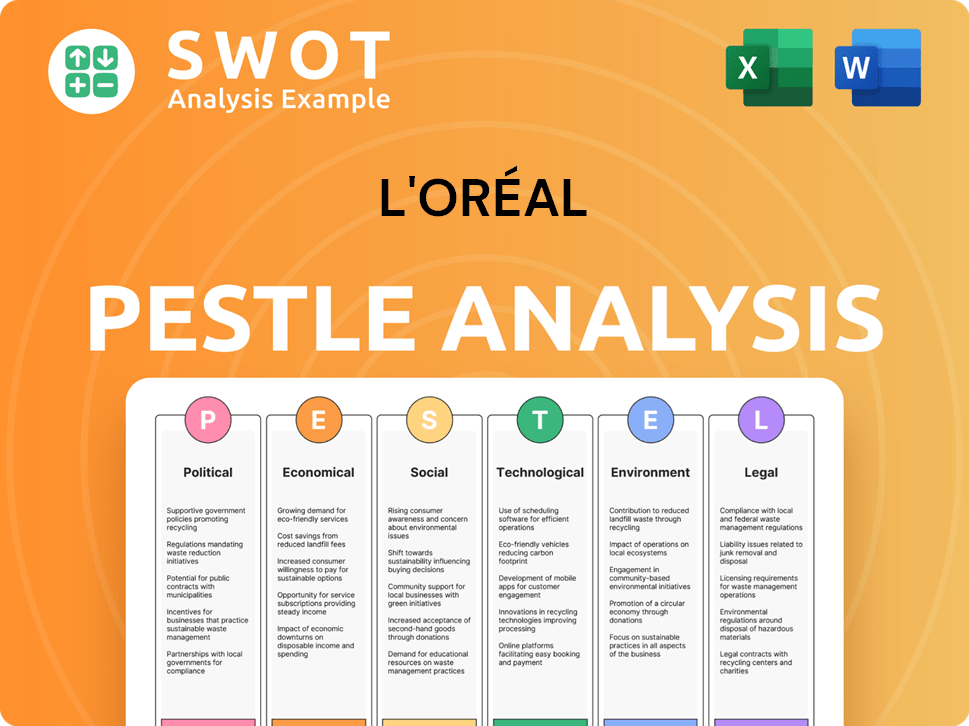
How Is L'Oréal Positioned in the Market?
The brand positioning of the company is a cornerstone of its global success in the beauty industry. This strategy centers on a core message of quality, innovation, and empowerment, consistently communicated across its diverse portfolio of brands. The iconic tagline, 'Because You're Worth It,' is a powerful expression of this commitment, resonating with consumers worldwide and building trust.
The company employs a differentiation strategy, targeting a broad audience that includes middle, upper-middle-class, and high-income consumers. This approach is supported by a diverse brand portfolio and a focus on innovation, offering cutting-edge beauty solutions. Furthermore, the company's commitment to sustainability is a key element of its brand positioning, appealing to environmentally conscious consumers.
The company's success in the beauty industry is significantly shaped by its brand positioning. This strategy is built on quality, innovation, and empowerment, which is reinforced by its famous tagline, 'Because You're Worth It.' This message is consistently applied across its extensive portfolio of brands, fostering a unified identity that builds consumer trust. This approach has allowed the company to establish itself as a global leader in the beauty industry.
The company's brand identity is meticulously crafted to position itself as a global leader in the beauty industry. This is achieved through a core message of quality, innovation, and empowerment. The iconic tagline, 'Because You're Worth It,' reinforces this commitment to self-worth, resonating with consumers worldwide.
The company employs a differentiation strategy, appealing to a wide target market. Its diverse brand portfolio caters to middle, upper-middle-class, and high-income consumers. This strategy is supported by a focus on innovation, offering cutting-edge beauty solutions, and a commitment to sustainability.
The 'L'Oréal for the Future' program, launched in 2020, outlines ambitious sustainability targets. These include reaching 100% renewable energy use on operated sites by 2025 and reducing virgin plastic for product packaging by 50% by 2030. The company received a platinum medal by EcoVadis in 2024 for its environmental and social performance.
The company's strategy of 'universalization' aims to globalize while respecting local differences. Campaigns are adapted to reflect diverse cultures and preferences, ensuring relevance and relatability. Continuous investment in research and development and a focus on emerging trends like men's grooming are also key.
The company's brand positioning is further strengthened by its adaptability and continuous innovation. Its focus on research and development, along with its commitment to emerging trends, ensures that it remains relevant in a dynamic market. The company's ability to adapt to shifts in consumer sentiment and competitive threats is a key factor in its sustained success. For more insights, explore the Growth Strategy of L'Oréal.
The company's marketing plan is designed to reach a broad audience through a diverse brand portfolio. This includes targeted advertising campaigns and strategic partnerships. The company allocates its marketing budget effectively to maximize reach and impact, focusing on both traditional and digital channels.
The company's target market includes middle, upper-middle-class, and high-income consumers worldwide. It segments its market to tailor its products and marketing efforts. The company's diverse brand portfolio caters to a wide range of consumer preferences and needs.
The company employs a variety of sales and marketing tactics to drive growth. These include digital marketing, social media campaigns, and e-commerce strategies. The company focuses on customer relationship management to build brand loyalty and drive repeat purchases.
The company has a strong digital marketing strategy that includes social media marketing and e-commerce. It uses data analytics to understand consumer behavior and tailor its campaigns. The company's digital presence is designed to enhance customer engagement and drive sales.
The company focuses on customer relationship management to build brand loyalty. It uses data to personalize customer experiences and improve engagement. The company's CRM efforts are designed to drive repeat purchases and enhance customer lifetime value.
The company's global marketing strategy involves adapting campaigns to local markets while maintaining brand consistency. It focuses on 'universalization' to globalize while respecting local differences. This approach ensures relevance and relatability for consumers worldwide.
L'Oréal Business Model Canvas
- Complete 9-Block Business Model Canvas
- Effortlessly Communicate Your Business Strategy
- Investor-Ready BMC Format
- 100% Editable and Customizable
- Clear and Structured Layout
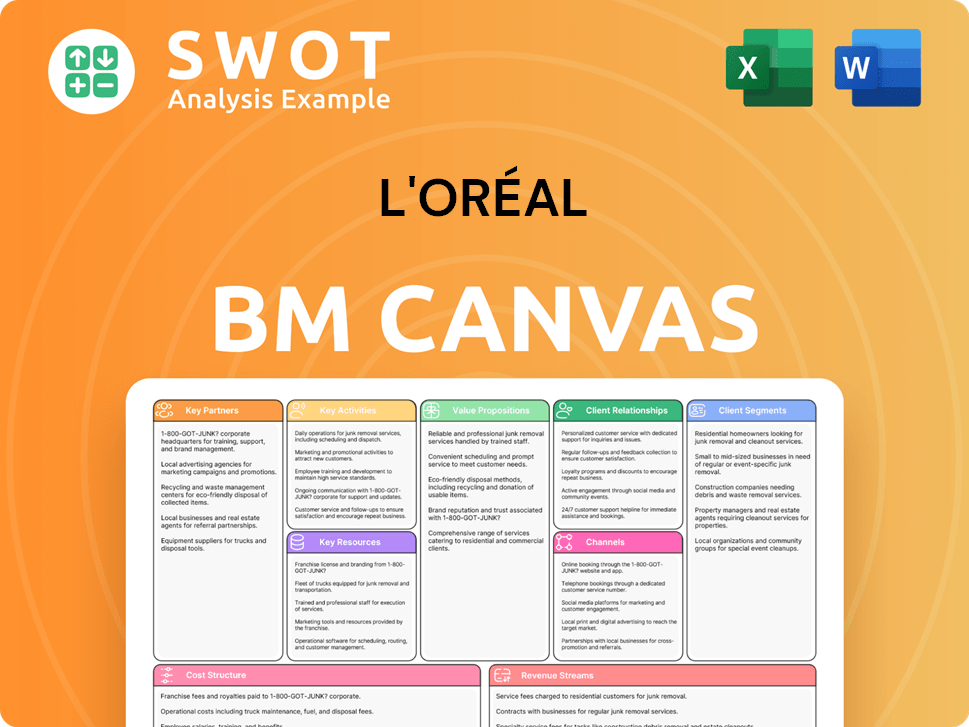
What Are L'Oréal’s Most Notable Campaigns?
The success of L'Oréal's L'Oréal sales strategy and
L'Oréal's marketing plan includes a variety of strategies, from product launches to leveraging digital platforms. These campaigns are carefully constructed to resonate with consumers, build brand loyalty, and increase market share. The company's approach integrates technological advancements and consumer insights.
The 'Beauty Stimulus' Plan, launched in 2025, is an example of L'Oréal's ongoing commitment to innovation. This plan involves new product launches to drive growth in various markets. This initiative demonstrates L'Oréal's dedication to pushing boundaries in beauty through scientific advancements and product development.
L'Oréal uses AI-powered tools like L'Oréal Paris Beauty Genius for personalized product recommendations. This virtual beauty assistant incorporates AI, AR, and computer vision. This helps to enhance customer engagement and provides customized beauty solutions.
Collaborations with influencers and celebrities are a key part of L'Oréal's strategy. These partnerships boost brand visibility and credibility. Featuring local celebrities helps resonate with specific markets, as seen in India.
The 'By Garnier, Naturally' campaign highlights L'Oréal's commitment to sustainability. This campaign focuses on natural ingredients and eco-friendly packaging. This aligns with the company's broader 'L'Oréal for the Future' program.
L'Oréal's digital marketing strategy involves consistent engagement with consumers on social media. Data-driven approaches are used to build trust and inform new product development. Augmented marketing strategies, using GenAI, enhance the creative process.
L'Oréal's advertising campaigns examples demonstrate its commitment to innovation and customer engagement. These campaigns are designed to meet the changing demands of the L'Oréal target market. The company uses a variety of tactics to stay ahead.
- AI-powered tools for personalized beauty experiences.
- Influencer collaborations to increase brand visibility.
- Sustainability initiatives to align with consumer values.
- Data-driven marketing to build trust and inform product development.
L'Oréal Porter's Five Forces Analysis
- Covers All 5 Competitive Forces in Detail
- Structured for Consultants, Students, and Founders
- 100% Editable in Microsoft Word & Excel
- Instant Digital Download – Use Immediately
- Compatible with Mac & PC – Fully Unlocked
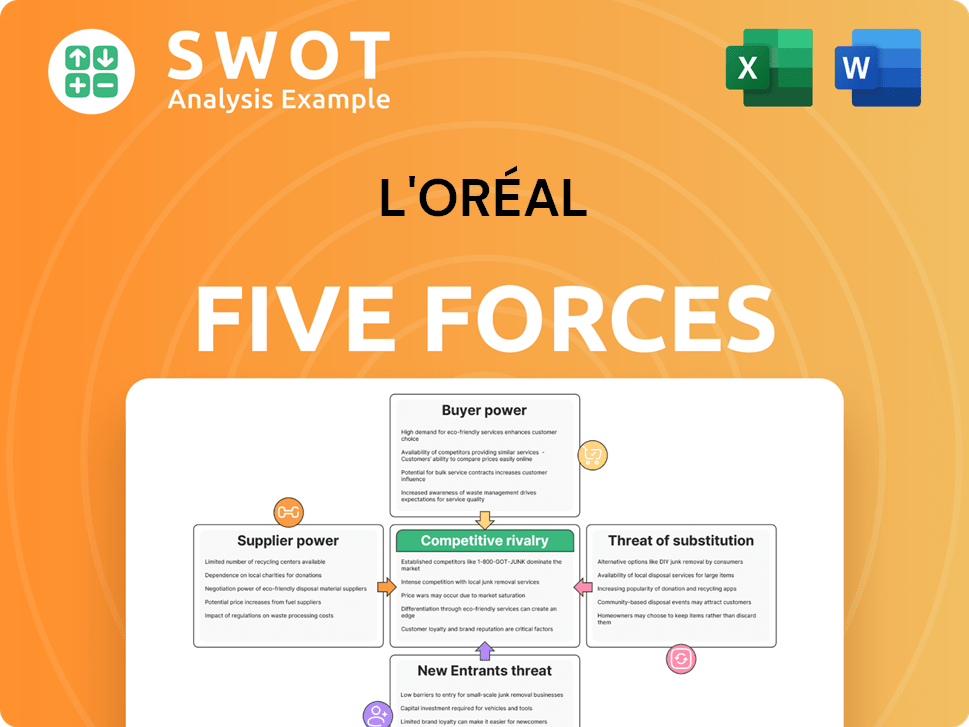
Related Blogs
- What are Mission Vision & Core Values of L'Oréal Company?
- What is Competitive Landscape of L'Oréal Company?
- What is Growth Strategy and Future Prospects of L'Oréal Company?
- How Does L'Oréal Company Work?
- What is Brief History of L'Oréal Company?
- Who Owns L'Oréal Company?
- What is Customer Demographics and Target Market of L'Oréal Company?
Disclaimer
All information, articles, and product details provided on this website are for general informational and educational purposes only. We do not claim any ownership over, nor do we intend to infringe upon, any trademarks, copyrights, logos, brand names, or other intellectual property mentioned or depicted on this site. Such intellectual property remains the property of its respective owners, and any references here are made solely for identification or informational purposes, without implying any affiliation, endorsement, or partnership.
We make no representations or warranties, express or implied, regarding the accuracy, completeness, or suitability of any content or products presented. Nothing on this website should be construed as legal, tax, investment, financial, medical, or other professional advice. In addition, no part of this site—including articles or product references—constitutes a solicitation, recommendation, endorsement, advertisement, or offer to buy or sell any securities, franchises, or other financial instruments, particularly in jurisdictions where such activity would be unlawful.
All content is of a general nature and may not address the specific circumstances of any individual or entity. It is not a substitute for professional advice or services. Any actions you take based on the information provided here are strictly at your own risk. You accept full responsibility for any decisions or outcomes arising from your use of this website and agree to release us from any liability in connection with your use of, or reliance upon, the content or products found herein.